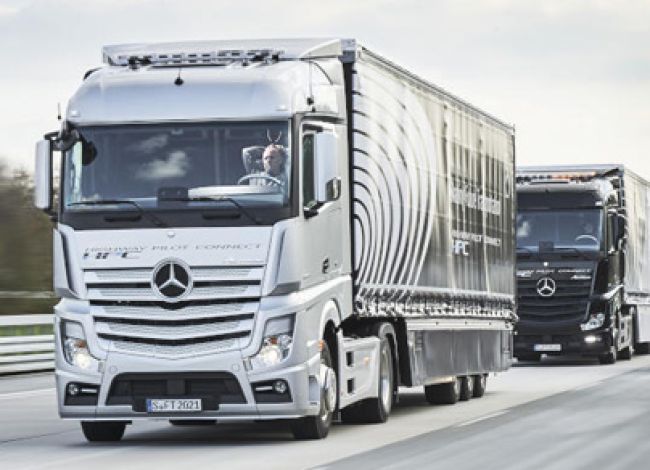
On Your Radar: The Latest Developments in Self-Driving Vehicles
Only a decade ago, the idea that self-driving cars could ever become mainstream within our lifetimes seemed far-fetched. Then came Google in 2009 with its fleet of retrofitted Prius hybrids and Lexus SUVs, which have since logged over 1.5 million autonomous-driving miles. And today, most major automakers, including upstart Tesla Motors, have also entered the race, with industry experts predicting that fully autonomous vehicles will enter the market within the next five to 10 years.
What’s fueling this momentum toward a self-driving world? There are many factors, but here are three interesting recent developments to keep your eye on.
1. Connected Convoys
Imagine three semitrailer trucks traveling at highway speed, one behind the other, with fewer than 50 feet between each vehicle. With conventional trucks, that’s a surefire recipe for a multivehicle pileup. But what if those three trucks were “connected” as a single autonomous platoon? Daimler is banking that its answer to this question will lead to improved safety and fuel economy, while contributing to advancements in the company’s autonomous truck technology.
In early April, three autonomous Mercedes-Benz semitrailer trucks completed a cross-border convoy drive from Stuttgart in Germany to Rotterdam in the Netherlands – about 400 miles – as a connected platoon.
The trucks were equipped with Daimler’s Highway Pilot Connect, which leverages electronic vehicle-to-vehicle networking between the trucks, allowing electronic docking – or platooning – by vehicles on long-distance highways. Connected vehicles in a platoon require a distance of only 15 meters (49 feet) between them instead of the typical 50 meters (164 feet), which significantly reduces aerodynamic drag, achieving fuel savings of up to 10 percent.
According to Daimler, connected-truck platooning also makes road traffic safer. That’s because while a human behind the wheel has a reaction time of 1.4 seconds, Highway Pilot Connect transmits braking signals to the vehicles in fewer than 0.1 seconds.
2. Sensors That See at Night
Just as humans must be able to see to drive, so must self-driving cars – and they see through sensor technologies, such as light detection and ranging (LiDAR), camera systems, sonar and radar. But what happens when the car can’t see potential hazards at night before it’s too late? Ford Motor Co. is making progress toward solving the night-visibility problem with its Fusion hybrid autonomous research vehicle.
A recent test at Ford’s Arizona proving grounds showed that its LiDAR system – working with the car’s virtual driver software – can steer the vehicle along winding roads in the dark of night, even without the use of headlights. The Ford self-driving car uses a high-resolution 3-D map that provides the vehicle with the latest information about the road, road markings, geography, topography and landmarks, such as signs, buildings and trees. And then the LiDAR system, at a rate of 2.8 million laser pulses per second, pinpoints precisely where the vehicle is positioned on that 3-D map so the vehicle can safely navigate its surroundings.
3. Partnerships Between Automakers and Silicon Valley Startups
Major automakers are expanding their presence in Silicon Valley and forming relationships with emerging technology startups that could help accelerate development of autonomous vehicle technologies. Following are a couple recent examples.
In January, General Motors said it would invest $500 million in the ride-sharing company Lyft in a venture that gives the automaker direct access to the growing market for ride-sharing and a potential channel for offering self-driving cars for on-demand use. GM is also in the process of acquiring Cruise Automation, a 3-year-old startup that has developed a highway autopilot system, which could help the automaker accelerate its autonomous vehicle development.
In April, both the Associated Press and The Wall Street Journal reported that Fiat Chrysler and Google are in advanced talks to form a technical partnership. The partnership would be the first to match an automaker with Google’s autonomous car project.
This trend toward partnerships shows that self-driving vehicles aren’t viewed by automakers as a novelty or fringe technology; instead they are something that’s being taken seriously as a future product offering.
*****
The Move Toward a Self-Driving World: By the Numbers
32,675: The number of lives lost on U.S. roads in 2014, according to the National Highway Traffic Safety Administration (NHTSA). This is roughly equivalent to one Boeing 747 aircraft falling from the sky, killing all 600 passengers, each and every week throughout the year.
94: The percentage of fatal crashes that NHTSA estimates is attributed to human error or decision. The logic: Remove the human, eliminate human error and save lives.
50: The average commute time in minutes based on U.S. Department of Commerce data. Imagine how much more you could get done with almost an extra hour each workday.
129,000,000: The number of autonomous-capable vehicles expected to be sold globally from 2020 to 2035, according to Navigant Research.

